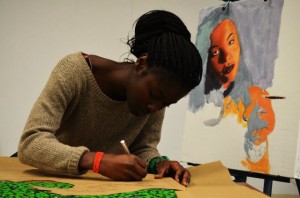By Christopher Squier
squierch@grinnell.edu
Involved in photography, Ghanaian fashion design and fabric dyeing, as well as a number of summer architecture internships in London, Na Chainkua Reindorf ’14 is well-versed in a wide variety of artistic practices and processes. At Grinnell, however, the Ghanaian studio art major has tended to concentrate her efforts on examining the difficulties of identity from various perspectives.
“I want my art to make people think about different issues,” Reindorf said. “I don’t want it to be overtly obvious or too subtle, but enough to make people ask, ‘how did she do that and why?’”
For example, Reindorf is currently working on a painting investigating multiple identities and the way in which Western colonization and globalization has affected Ghanaian life, and in specific, the Ghanaian art world.

Reindorf’s intent is to create a work of art involving both paint and fabric collage. Wax resist dyed fabrics play an interesting role in Africa, symbolizing both specific African cultures and a connection through trade and manufacture to Europe and the Western world—a connection that has likely only increased through the process of globalization.
Through her experience with fashion design in Ghana, Reindorf has a personal connection to working with fabrics. She also draws inspiration from the British-Nigerian artist Yinka Shonibare, who works with similar themes of post-colonialism and race and identity issues.
Two of Reindorf’s current works involve mixed identities: one brings up the ambivalent cultural heritages of fabrics through collage, while the other creates confusion about identity through the symbolic portrayal of different cultures. The latter is a painting showing a mixed-race girl smoking a cigarette, a symbol of Westernization.
“This painting is basically commenting on people trying to fix the problem of identity,” Reindorf said. “Trying to find your identity while staying true to where you’re from.”
In her other works, including prints and charcoal drawings, Reindorf questions identity in a more general way. Working realistically with portraiture and portrayals of the human body, she examines the ways in which identity is construed and recognized from different perspectives.
Frequently, Reindorf depicts human faces, emphasizing identity in its most recognizable form. However, she also is interested in portraying human bodies without faces or with hidden faces, in order to obscure a nude’s identity. This process makes them anonymous in some ways, but not completely.
“None of them have faces as identifiers. I was … questioning; what do we need to form a person’s identity,” Reindorf said. “Without a face, how do you reconcile those two?”
The focus is often on female nudes, which she chooses because she identifies most with them. By making small-scale monotype prints obscuring women’s faces but exposing their bodies, Reindorf also brings up issues of the way we view people in visual media. These portraits may be seen as anything from casual glimpses of the everyday lives of women to prying into their intimate lives. The way the viewer sees the print seems to alter meaning and the ambiguity itself becomes interesting.
Moreover, Reindorf uses identity to talk about race and difference. Her interest results from her greater awareness of race upon coming to Grinnell.
“When you travel or when you’re outside of a country where almost everyone’s skin color is the same, you become more aware of yourself and how different you look. … I decided to comment on that with my artwork.”
Reindorf asks herself questions with her art about how we define ourselves, how we define others and how that plays into how we see ourselves. For Reindorf, as a Ghanaian artist, the way Western art has influenced African art is also part of this concern.
Although Western colonization at first misconstrued the meanings of Ghanaian art, the relationship became more complicated, with Ghanaian artists working within a framework of both older aesthetic values and the imported ideas of art brought by Europeans.
“There’s a tension, because you’re trying to create something that the whole world will understand, and so you distort the meaning of the work in order to fit everybody else’s view of what it would mean,” Reindorf said.
Reindorf tends to focus her attention in art making on color palette and color matching, among a variety of similar formal decisions. In some works, she aims for high contrast, referencing a 15th century technique called chiaroscuro, while in others she uses bright and lifelike colors.
“With my art, technically speaking, I am either very minimal with my color palette or I go all out,” Reindorf said. “I feel like I can look at a color and actually create it with the paint that I find. I find that process of finding the exact color as something I really enjoy doing.”
Through her work, it’s clear that Reindorf is in love with making art.
“I can’t see myself doing anything else, honestly, because I know I love something when I look forward to doing it,” Reindorf said. “That’s how I feel about art.”
Reindorf’s art can be viewed at her website at http://www.frodnier.com.

































































